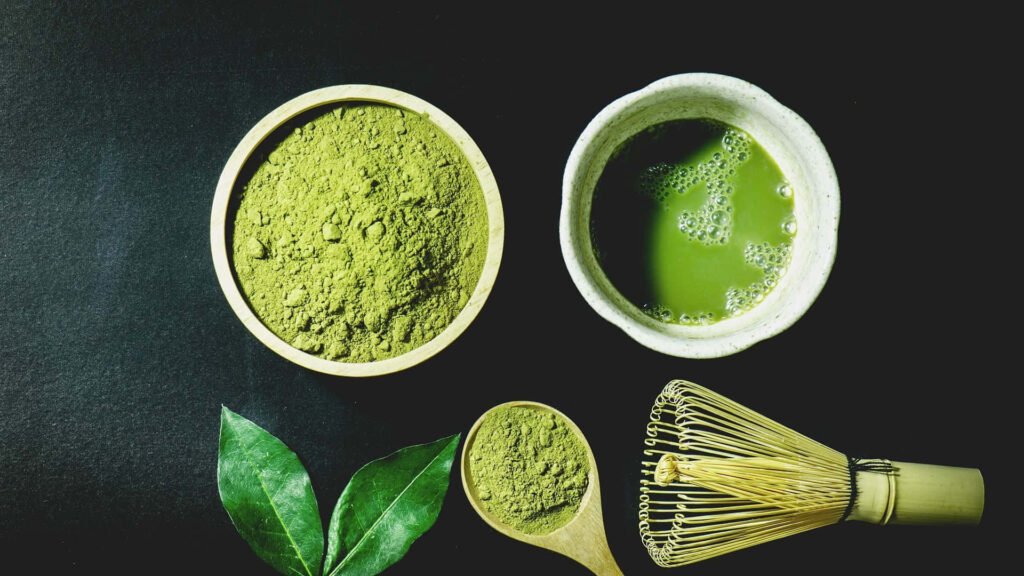What is Matcha?
Matcha is a finely milled or ground powder made from specially grown and processed green tea leaves. Unlike traditional green tea where the leaves are steeped in hot water, with matcha, the tea leaves themselves are consumed. Matcha boasts a vibrant green color, distinct earthy flavor, and offers a concentrated source of nutrients.
Originating in Japan, matcha has been an integral part of Japanese culture for centuries. The tea leaves used for matcha are grown in the shade, which increases chlorophyll production and gives the leaves a deeper green hue. After harvesting, the leaves are steamed, dried, and then stone-ground into a fine powder.
Matcha stands out due to its unique production method and the fact that the entire leaf is ingested, providing a more potent dose of antioxidants and other beneficial compounds compared to steeped green tea. With its rich umami flavor and vivid green color, Matcha has become a beloved ingredient in traditional Japanese tea ceremonies and has gained widespread popularity worldwide in recent years.
History and Cultural Significance
Matcha, the finely ground powder of specially grown and processed green tea leaves, has a rich and deeply ingrained history in Japanese culture dating back centuries. Its origins can be traced to the introduction of green tea seeds to Japan from China in the 12th century by Buddhist monks. However, it was during the Muromachi period (1336-1573) that matcha truly flourished and became an integral part of the traditional Japanese tea ceremony, Matcha.
The tea ceremony, or “Way of Tea,” was developed and refined by influential tea masters, such as Sen no Rikyū, who elevated the preparation and consumption of matcha to an art form. The tea ceremony was not just about drinking tea but rather a spiritual and aesthetic practice that embodied the principles of harmony, respect, purity, and tranquility.
Matcha played a central role in these ceremonies, with every aspect of its preparation and presentation being meticulously choreographed. From the carefully curated tea bowls and utensils to the precise movements and gestures of the tea master, the tea ceremony became a revered tradition that celebrated the beauty of imperfection, the fleeting nature of life, and the appreciation of the present moment.
Production Process
Matcha production is a meticulous and labor-intensive process that requires great skill and attention to detail. The journey begins with the cultivation of special shade-grown tea plants, typically the Tencha cultivar. Approximately three to four weeks before the harvest, the tea plants are covered with bamboo or synthetic shades to block out sunlight. This process, known as “shading,” causes the leaves to produce more chlorophyll, amino acids, and nutrients, resulting in a richer, sweeter flavor and brighter green color.
Once the leaves are ready, they are carefully hand-picked, with only the youngest and most tender leaves selected. The leaves are then steamed to halt oxidation and preserve their vibrant green color and fresh flavor. After steaming, the leaves are dried and de-stemmed, leaving only the delicate leaf blades.
The resulting matcha powder is then carefully sifted and graded according to its quality, color, and texture. The finest grades of matcha are velvety smooth, with a vibrant, jade-green hue and a sweet, umami-rich flavor. Lower grades may have a more coarse texture or a dull, brownish color.
Throughout the production process, great care is taken to preserve the delicate flavors and nutrients of the matcha leaves. The shading, steaming, and grinding techniques all contribute to the unique taste and character of matcha, setting it apart from other types of green tea.
Grades and Quality
Matcha comes in various grades, each with distinct characteristics and quality levels. The grade is primarily determined by the cultivation methods, harvesting techniques, and the part of the tea plant used. Generally, there are two main categories: ceremonial grade and culinary grade.
Ceremonial Grade Matcha
Ceremonial grade, or koicha, is the highest quality and most expensive type of matcha. It is made from the youngest, most tender leaves picked by hand from tea plants grown in shade. These leaves are carefully processed to preserve their vibrant green color, delicate flavor, and high nutrient content. Ceremonial grade matcha has a smooth, creamy texture and a naturally sweet, umami-rich taste with no bitterness or astringency.
Age of the Leaves
The youngest, most tender leaves from the first flush of the growing season are considered the highest quality. As the leaves mature, their flavor and nutrient content change. Matcha
Color and Texture
Premium matcha should have a vibrant, deep green color and a silky-smooth texture without any grittiness or clumping. Dull or yellowish hues may indicate inferior quality or improper storage.
When purchasing matcha, look for products from reputable sources that provide information about the grade, origin, and production methods. High-quality matcha should have a fresh, slightly sweet aroma and a rich, umami flavor without bitterness or off-notes. With its exceptional taste and potential health benefits, investing in premium matcha can elevate your culinary and ceremonial experiences.
Health Benefits
Matcha is packed with nutrients that offer potential health benefits. It is rich in antioxidants, particularly catechins like epigallocatechin gallate (EGCG), which have been linked to various positive effects on human health.
Nutritional Profile
Matcha is an excellent source of several essential vitamins and minerals. A single serving provides significant amounts of vitamin A, vitamin C, vitamin E, vitamin K, and several B vitamins. It is also a good source of minerals like chromium, zinc, and magnesium.
Moreover, matcha is rich in amino acids, including L-theanine, which is known for its calming and relaxing effects. It also contains dietary fiber, which aids in digestion and promotes feelings of fullness.
Potential Health Benefits
-
Boosts Metabolism and Aids Weight Loss: The combination of caffeine and EGCG in matcha may help boost metabolism and increase fat burning, potentially aiding weight loss efforts.
-
Boosts Brain Function: The combination of L-theanine and caffeine in matcha has been shown to improve cognitive performance, including memory, reaction time, and attention span.
-
Promotes Relaxation and Stress Relief: While providing a gentle energy boost, the L-theanine in matcha can also promote relaxation and reduce stress levels, making it a unique beverage for both focus and calm.
Matcha’s nutrient-dense profile and potential health benefits make it a valuable addition to a balanced diet and lifestyle.
Preparing Matcha
Preparing matcha tea is an art form steeped in tradition, yet it has also evolved to accommodate modern lifestyles. The traditional method involves a series of precise steps and specialized tools, creating a meditative ritual that honors the cultural heritage of matcha. Superpowers of Matcha
Traditional Preparation:
- Utensils: Gather a ceramic bowl (chawan), a bamboo whisk (chasen), and a bamboo scoop (chashaku).
- Sifting: Sift a small amount of matcha powder (usually around 1-2 teaspoons) into the chawan using the chashaku.
- Adding Water: Heat water to around 170-180°F (75-80°C) and add a small amount (around 2-3 ounces) to the chawan.
- Whisking: Using the chasen, whisk the matcha and water in a zigzag motion until a smooth, frothy consistency is achieved. This vigorous whisking is essential to create the desired texture and flavor.
- Serving: Traditionally, matcha is served in the chawan, and the entire bowl is consumed.
Modern methods have adapted the traditional preparation to suit contemporary lifestyles while preserving the essence of the ritual.
Modern Preparation:
- Matcha Powder: Use high-quality matcha powder, preferably from reputable sources.
- Utensils: While traditional tools are still used by purists, modern alternatives like a small whisk or even a milk frother can be employed.
- Heating Water: Bring water to a boil and then allow it to cool slightly to around 175-185°F (80-85°C).
- Whisking: Add matcha powder to a mug or bowl, and slowly pour in the hot water while whisking vigorously to create a frothy consistency.
- Serving: Matcha can be enjoyed hot or iced, with or without additional ingredients like milk, honey, or sweeteners.
Whether following the traditional or modern approach, the key to a perfect cup of matcha lies in using high-quality matcha powder, achieving the right water temperature, and whisking thoroughly to unlock the tea’s unique flavor and health benefits. Superpowers of Matcha
Matcha in Cuisine
Matcha’s vibrant green color and distinct umami flavor make it a versatile ingredient in both sweet and savory culinary applications. While traditionally consumed as a tea, matcha has found its way into various dishes and beverages, adding a unique twist to familiar recipes.
In baking, matcha powder can be incorporated into batters and doughs, lending a beautiful green hue and earthy taste to cakes, cookies, and pastries. Matcha pairs particularly well with white chocolate, creating a harmonious balance of flavors. Matcha-infused buttercreams and frostings are also popular, adding a visually striking and delicious topping to cakes and cupcakes.
Matcha can also be used in savory dishes, such as matcha-infused pasta, risotto, or even matcha-crusted proteins like fish or chicken. Its slightly bitter and nutty notes complement rich ingredients like cream, butter, and cheese, creating depth and complexity in the dish.
Beyond baked goods and entrees, matcha is a popular addition to various beverages.
Matcha Ceremonies and Traditions
It is a meditative practice that encourages participants to appreciate the present moment and find beauty in simplicity.
Beyond the tea ceremony, matcha has also been incorporated into various other cultural traditions in Japan. During the Samurai era, warriors consumed matcha before battle, believing it enhanced their alertness and focus. In Zen Buddhism, matcha is revered for its ability to promote mindfulness and concentration during meditation sessions.
Matcha has also played a significant role in Japanese art and literature. The vibrant green hue of matcha has inspired countless works of art, from intricate ceramics to delicate ink paintings.
Buying and Storing Matcha
When it comes to buying matcha, quality should be the top priority. High-quality matcha is vibrant green in color, with a fine, silky texture and a rich, slightly sweet flavor. Look for matcha that is stone-ground from premium tencha leaves, as this traditional method preserves the delicate flavors and nutrients.
Reputable tea companies and specialty stores are the best sources for purchasing matcha. Be wary of overly cheap matcha, as it may be low-grade or contain additives. Check the packaging for information on the origin, harvest season, and grade of the matcha.
Proper storage is crucial for maintaining the freshness and flavor of matcha. Matcha is highly susceptible to oxidation, which can cause it to lose its vibrant green color and develop an unpleasant taste. Always store matcha in an airtight, opaque container, away from direct sunlight, moisture, and strong odors.
Refrigeration is recommended for long-term storage, as it slows down the oxidation process. However, avoid exposing the matcha to extreme temperature fluctuations, as this can cause condensation and spoilage.
When stored correctly, matcha can maintain its quality for up to 6-12 months. However, it’s best to consume it within a few months of purchase for optimal flavor and freshness. If the matcha has lost its vibrant green color or developed an off-taste, it’s time to replace it.
Matcha Around the World
The global popularity of this finely milled green tea powder has skyrocketed in recent years as people around the world have discovered its unique flavor, potential health benefits, and cultural significance. While it has deep roots in Japanese tradition, its appeal has transcended borders and cultures.
In North America and Europe, the green tea powder gained a foothold initially through the growing interest in Japanese cuisine and culture. Specialty tea shops and Japanese restaurants introduced it to adventurous foodies and tea enthusiasts. As awareness of its purported health benefits spread, it found its way into coffee shops, cafes, and the inventive creations of pastry chefs and baristas.
Today, it is ubiquitous in major cities, appearing in everything from lattes and smoothies to cakes, cookies, and even savory dishes. Trendy cafes have popped up, devoted entirely to showcasing the versatility of this brilliant green powder. Social media has played a significant role, with vibrant desserts and beverages becoming Instagram sensations.
The unique preparation methods and ceremonial traditions associated with this green tea powder have fascinated tea lovers in these regions.
Even in parts of the world without a strong tea tradition, it is making inroads. In Australia and New Zealand, it features prominently in the thriving cafe culture. In the Middle East, it is finding its way into traditional sweets and beverages. And in South America, it is being embraced by health-conscious consumers seeking alternatives to coffee and sugary drinks.
As the world becomes increasingly interconnected and curious about diverse culinary experiences, its global journey is likely just beginning. Its distinctive flavor, vibrant color, and potential health benefits make it a versatile and intriguing ingredient that transcends cultural boundaries.



What Experts In The Field Of Mesothelioma Litigation Want You To Know reputable asbestos attorney
10 Facts About Defra Exempt Multi Fuel Stoves That Will Instantly Set You In A Positive Mood DEFRA approved traditional stoves
The 12 Most Popular Hyundai Key Accounts To Follow On Twitter service
15 Astonishing Facts About Private ADHD Assesment private adhd asd assessment near me (Layla)
What’s The Current Job Market For Replacement Lexus Key Professionals Like?
replacement lexus Key
The 10 Scariest Things About Replacement Bmw Keys replacement Bmw key
How To Save Money On Toto4d bandar toto
Five Things You’ve Never Learned About Truck Accident Lawyers Truck Accident Attorney
The 9 Things Your Parents Teach You About Bed With Couch bed with couch (Nicholas)
I am not sure where youre getting your info but good topic I needs to spend some time learning much more or understanding more Thanks for magnificent info I was looking for this information for my mission
See What Replace Bifold Doors Tricks The Celebs
Are Using replace bifold doors